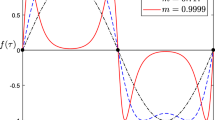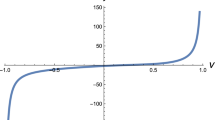Abstract
The current work is devoted to the analytical study of the dynamics of piecewise linear (PWL) oscillators subjected to various types of excitations. Straightforward analytical study of the response of this class of strongly nonlinear oscillators is rather complex, as it requires the computation of time instants of transitions from one linear state to another. This difficulty is commonly overcome by using the averaging procedure. In the present study, we devise an averaging method which naturally fits to the analysis of a general class of resonantly forced PWL systems with zero offset. This method is based on introduction of non-analytic PWL basis functions with corresponding algebra thereby enabling the application of direct averaging method to the resonantly forced, strongly nonlinear PWL oscillators (PWLOs). We demonstrate the efficiency of the considered averaging method for the three different cases of forced PWLOs. We first consider the PWL Mathieu equation and asymptotically obtain the relatively simple analytical expressions for the transition curves corresponding to the most significant family of m:1 sub-harmonic resonances for both damped and undamped cases. The second dynamical system considered herein is a PWL Van der Pol oscillator. In this example, we use the derived averaged model to explore the effect of asymmetry parameter on the limit cycle oscillations. As a final example, we consider an externally forced PWL Duffing oscillator to illustrate the effect of stiffness asymmetry parameter on its resonance curves. Results of the analysis for all the three considered models show a fairly good correspondence with the numerical simulations of the model within the limit of asymptotic validity.

















Similar content being viewed by others
Data availability
Enquiries about data availability should be directed to the authors.
References
Wiercigroch, M.: Chaotic vibration of a simple model of the machine tool-cutting process system. J. Vib. Acoust. 119, 468–475 (1997)
Davies, M.A., Balachandran, B.: Impact dynamics in milling of thin-walled structures. Nonlinear Dyn. 22, 375–392 (2000)
Chati, M., Rand, R., Mukherjee, S.: Modal analysis of a cracked beam. J. Sound Vib. 207(2), 249–270 (1997)
Shen, M.H.H., Pierre, C.: Natural modes of Bernoulli–Euler beams with symmetric cracks. J. Sound Vib. 138, 115–134 (1990)
Ostachowicz, W.M., Krawczuk, M.: Analysis of the effect of cracks on the natural frequencies of a cantilever beam. J. Sound Vib. 150, 191–201 (1991)
Chu, Y.C., Shen, H.H.: Analysis of forced bilinear oscillators and the application to cracked beam dynamics. AIAA J. 10, 2512–2519 (1992)
Andreaus, U., Casini, P., Vestroni, F.: Non-linear dynamics of a cracked cantilever beam under harmonic excitation. Int. J. Non-Linear Mech. 42, 566–575 (2007)
Doole, S.H., Hogan, S.J.: A piecewise linear suspension bridge model: Nonlinear dynamics and orbit continuation. Dyn. Stab. Syst. 11, 19–47 (1996)
Dyskin, A.V., Pasternak, E., Pelinovsky, E.: Modelling resonances in topological interlocking structures. In: Fifth Australasian Congress on Applied Mechanics, ACAM 2007, Brisbane (2007)
Dyskin, A.V., Pasternak, E., Estrin, Y.: Mortarless structures based on topological interlocking. Front. Struct. Civ. Eng. 6(2), 188–197 (2012)
Andreaus, U., Angelis, M.D.: Nonlinear dynamic response of a base-excited SDOF oscillator with double-side unilateral constraints. Nonlinear Dyn. 84(3), 1447–1467 (2016)
Andreaus, U., Baragatti, P., Angelis, M.D., Perno, S.: Shaking table tests and numerical investigation of two-sided damping constraint for end-stop impact protection. Nonlinear Dyn. 90(4), 2387–2421 (2017)
Andreaus, U., Baragatti, P., Angelis, M.D., Perno, S.: A preliminary experimental study about two-sided impacting SDOF oscillator under harmonic excitation. J. Comput. Nonlinear Dyn. 12(6), 061010 (2017)
Andreaus, U., Angelis, M.D.: Experimental and numerical dynamic response of a SDOF vibro impact system with double gaps and bumpers under harmonic excitation. Int. J. Dyn. Control 7, 1278–1292 (2019)
Andreaus, U., Angelis, M.D.: Influence of the characteristics of isolation and mitigation devices on the response of SDOF vibro-impact systems with two-sided bumpers and gaps via shaking table tests. Struct. Control Health Monit. 27(5), 1–21 (2020)
Stefani, G., Angelis, M.D., Andreaus, U.: Influence of the gap size on the response of a single-degree-of-freedom vibro-impact system with two-sided constraints: experimental tests and numerical modeling. Int. J. Mech. Sci. 206, 1–16 (2021)
Stefani, G., Angelis, M.D., Andreaus, U.: Scenarios in the experimental response of a vibro-impact single-degree-of-freedom system and numerical simulations. Nonlinear Dyn. 103, 3465–3488 (2021)
Stefani, G., Angelis, M.D., Andreaus, U.: The effect of the presence of obstacles on the dynamic response of single-degree-of-freedom systems: study of the scenarios aimed at vibration control. J. Sound Vib. 531(116949), 1–21 (2022)
Stefani, G., DeAngelis, M., Andreaus, U.: Numerical study on the response scenarios in a vibro-impact single-degree-of-freedom oscillator with two unilateral dissipative and deformable constraints. Commun. Nonlinear Sci. Numer. Simul. 99, 1–30 (2021)
Maezawa, S.: Superharmonic resonance in pieceise linear systems with unsymmetrical characteristics. In: 5th International Conference on Nonlinear Oscillations, Kiev (1969)
Maezewa, S., Kumano, H., Minakuchi, Y.: Forced vibrations in an unsymmetric piecewise linear system excited by general periodic force functions. Bull. Jpn. Soc. Mech. Eng. 23(175), 68–75 (1980)
Thompson, J.M.T., Bokaian, A.R., Ghaffari, R.: Subharmonic resonances and chaotic motions of a bilinear oscillator. IMA J. Appl. Math. 31, 207–234 (1983)
Shaw, S.W., Holmes, P.J.: A periodically forced piecewise linear oscillator. J. Sound Vib. 90(1), 129–155 (1983)
Natsiavas, S.: On the dynamics of oscillators with bi-linear damping and stiffness. Int. J. Non-Linear Mech. 25(5), 535–554 (1990)
Shaw, S.W.: Forced vibrations of a beam with one-sided amplitude constraint: theory and experiment. J. Sound Vib. 99(2), 199–212 (1985)
Ehrich, F.F.: Observations of sub-critical super-harmonic and chaotic responses. ASME J. Vib. Acoust. 114, 93–100 (1992)
Theodossiades, S., Natsiavas, S.: Nonlinear dynamics of gear pair systems with periodic stiffness and backlash. J. Sound Vib. 229, 287–310 (2000)
Natsiavas, S., Theodossiades, S., Goudas, I.: Dynamic analysis of piecewise linear oscillators with time periodic coefficients. Int. J. Non-Linear Mech. 35, 53–68 (2000)
Marathe, A., Chatterjee, A.: Asymmetric Mathieu equation. Proc. R. Soc. A 462, 1643–1659 (2006)
Jayaprakash, K.R., Starosvetsky, Y.: Analytical study of the transition curves in the bi-linear Mathieu equation. Nonlinear Dyn. 101(2), 1–13 (2020)
Kumar, A., Starosvetsky, Y.: Analysis of transition regions in the parametrically forced system of bi-linear oscillators: resonant excitation in the neighborhood of similar modes. J. Sound Vib. 515, 1–17 (2021)
Gendelman, O.V., Sapsis, T.P.: Energy exchange and localization in essentially nonlinear oscillatory systems: canonical formalism. J. Appl. Mech. 84(011009), 1–9 (2017)
Bogoliubov, N.N., Mitropolsky, Y.A.: Asymptotic Methods in the Theory of Non-linear Oscillations. Gordon and Breach Science Publishers, New York (1961)
Nayfeh, A.H., Mook, D.T.: Nonlinear Oscillations. Wiley, New York (1995)
Chatterjee, A.: Harmonic balance based averaging: approximate realizations of an asymptotic technique. Nonlinear Dyn. 32, 323–343 (2003)
Kovacic, I., Rand, R.: Straight-line backbone curve. Commun. Nonlinear Sci. Numer. Simul. 18, 2281–2288 (2013)
Iacono, R., Russo, F.: Class of solvable nonlinear oscillators with isochronous orbits. Phys. Rev. E 83, 027601 (2011)
Stoker, J.J.: Nonlinear Vibrations in Mechanical and Electrical Systems. Wiley, New York (1950)
Cesari, L.: Asymptotic Behavior and Stability Problems in Ordinary Differential Equations. Springer, Berlin (1971)
Kumar, A., Starosvetsky, Y., Jayaprakash, K.R.: Analysis of transition regions of bi-linear, parametrically driven, two-oscillator model: resonant excitation in the neighborhood of non-similar NNMs. Int. J. Non-Linear Mech. 145, 104074 (2022)
Boyce, W.E., DiPrima, R.C.: Elementary Differential Equations and Boundary Value Problems. John Wiley, New Jersey (2009)
Guckenheimer, J., Holmes, P.: Nonlinear Oscillations, Dynamical Systems and Bifurcations of Vector Fields. Springer, New York (1989)
Natsiavas, S.: Dynamics of piecewise linear oscillators with Van-der-Pol type damping. Int. J. Non-Linear Mech. 26(314), 349–366 (1991)
Natsiavas, S.: Dynamics of multiple-degree-of-freedom oscillators with colliding components. J. Sound Vib. 165(3), 439–453 (1993)
Lichtenberg, A.J., Lieberman, M.A.: Regular and Chaotic Dynamics. Springer, New York (1992)
Acknowledgements
KRJ and YS would like to acknowledge the support received through the SPARC project (Project Code: P483) funded by the MHRD, Government of India. YS would also like to acknowledge the support received by Israel Science Foundation (Grant number 1079/16).
Funding
SPARC project (Project Code: P483) funded by the MHRD, Government of India; Israel Science Foundation (Grant number 1079/16).
Author information
Authors and Affiliations
Corresponding author
Ethics declarations
Conflict of interest
There are no conflict of interests.
Additional information
Publisher's Note
Springer Nature remains neutral with regard to jurisdictional claims in published maps and institutional affiliations.
Appendices
Appendix A
The PWL function can be defined in terms of the Heaviside function in the form
The generalized derivative of the function \(K\left( \psi \right)\) thus takes the form
where the function \(\left| \psi \right|\) and its derivative \(\left| \psi \right|\) is defined in the form
Appendix B
The averaging of the vector field (Eq. 10) reads,
Appendix C
The averaging of the vector field (Eq. 17) reads
Appendix D
The averaging of the vector field (Eq. 21) reads
Rights and permissions
Springer Nature or its licensor (e.g. a society or other partner) holds exclusive rights to this article under a publishing agreement with the author(s) or other rightsholder(s); author self-archiving of the accepted manuscript version of this article is solely governed by the terms of such publishing agreement and applicable law.
About this article
Cite this article
Jayaprakash, K.R., Tandel, V. & Starosvetsky, Y. Dynamics of excited piecewise linear oscillators. Nonlinear Dyn 111, 5513–5532 (2023). https://doi.org/10.1007/s11071-022-08108-9
Received:
Accepted:
Published:
Issue Date:
DOI: https://doi.org/10.1007/s11071-022-08108-9




